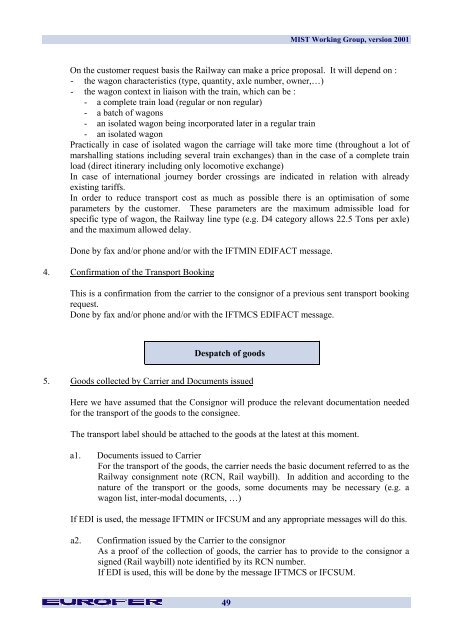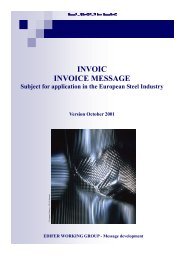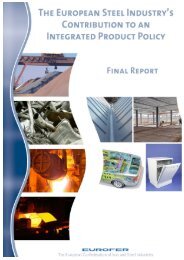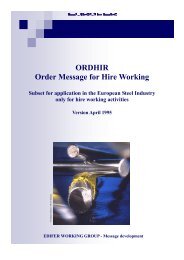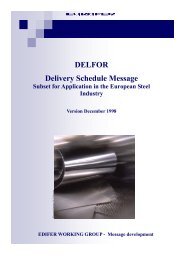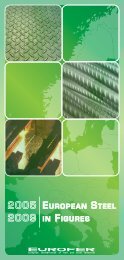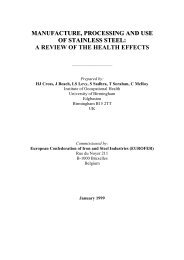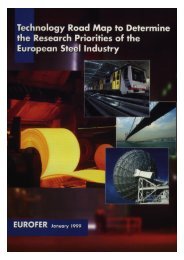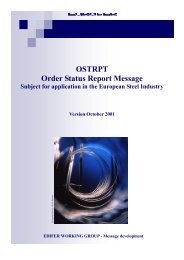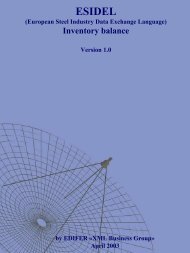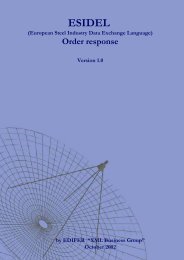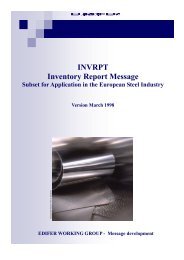Multi Industry Scenarios for Transport - Eurofer
Multi Industry Scenarios for Transport - Eurofer
Multi Industry Scenarios for Transport - Eurofer
Create successful ePaper yourself
Turn your PDF publications into a flip-book with our unique Google optimized e-Paper software.
49<br />
MIST Working Group, version 2001<br />
On the customer request basis the Railway can make a price proposal. It will depend on :<br />
- the wagon characteristics (type, quantity, axle number, owner,…)<br />
- the wagon context in liaison with the train, which can be :<br />
- a complete train load (regular or non regular)<br />
- a batch of wagons<br />
- an isolated wagon being incorporated later in a regular train<br />
- an isolated wagon<br />
Practically in case of isolated wagon the carriage will take more time (throughout a lot of<br />
marshalling stations including several train exchanges) than in the case of a complete train<br />
load (direct itinerary including only locomotive exchange)<br />
In case of international journey border crossings are indicated in relation with already<br />
existing tariffs.<br />
In order to reduce transport cost as much as possible there is an optimisation of some<br />
parameters by the customer. These parameters are the maximum admissible load <strong>for</strong><br />
specific type of wagon, the Railway line type (e.g. D4 category allows 22.5 Tons per axle)<br />
and the maximum allowed delay.<br />
Done by fax and/or phone and/or with the IFTMIN EDIFACT message.<br />
4. Confirmation of the <strong>Transport</strong> Booking<br />
This is a confirmation from the carrier to the consignor of a previous sent transport booking<br />
request.<br />
Done by fax and/or phone and/or with the IFTMCS EDIFACT message.<br />
Despatch of goods<br />
5. Goods collected by Carrier and Documents issued<br />
Here we have assumed that the Consignor will produce the relevant documentation needed<br />
<strong>for</strong> the transport of the goods to the consignee.<br />
The transport label should be attached to the goods at the latest at this moment.<br />
a1. Documents issued to Carrier<br />
For the transport of the goods, the carrier needs the basic document referred to as the<br />
Railway consignment note (RCN, Rail waybill). In addition and according to the<br />
nature of the transport or the goods, some documents may be necessary (e.g. a<br />
wagon list, inter-modal documents, …)<br />
If EDI is used, the message IFTMIN or IFCSUM and any appropriate messages will do this.<br />
a2. Confirmation issued by the Carrier to the consignor<br />
As a proof of the collection of goods, the carrier has to provide to the consignor a<br />
signed (Rail waybill) note identified by its RCN number.<br />
If EDI is used, this will be done by the message IFTMCS or IFCSUM.


